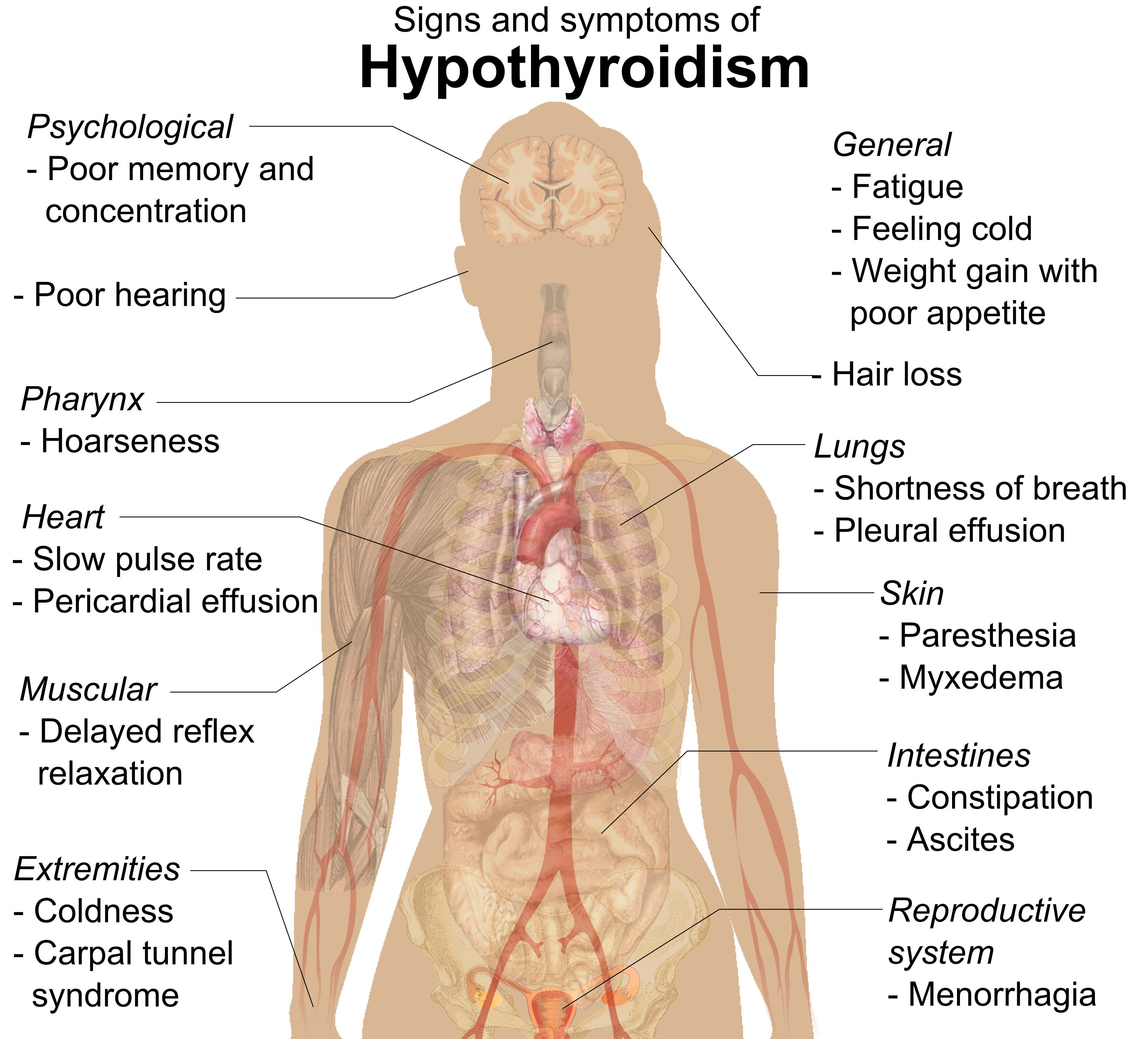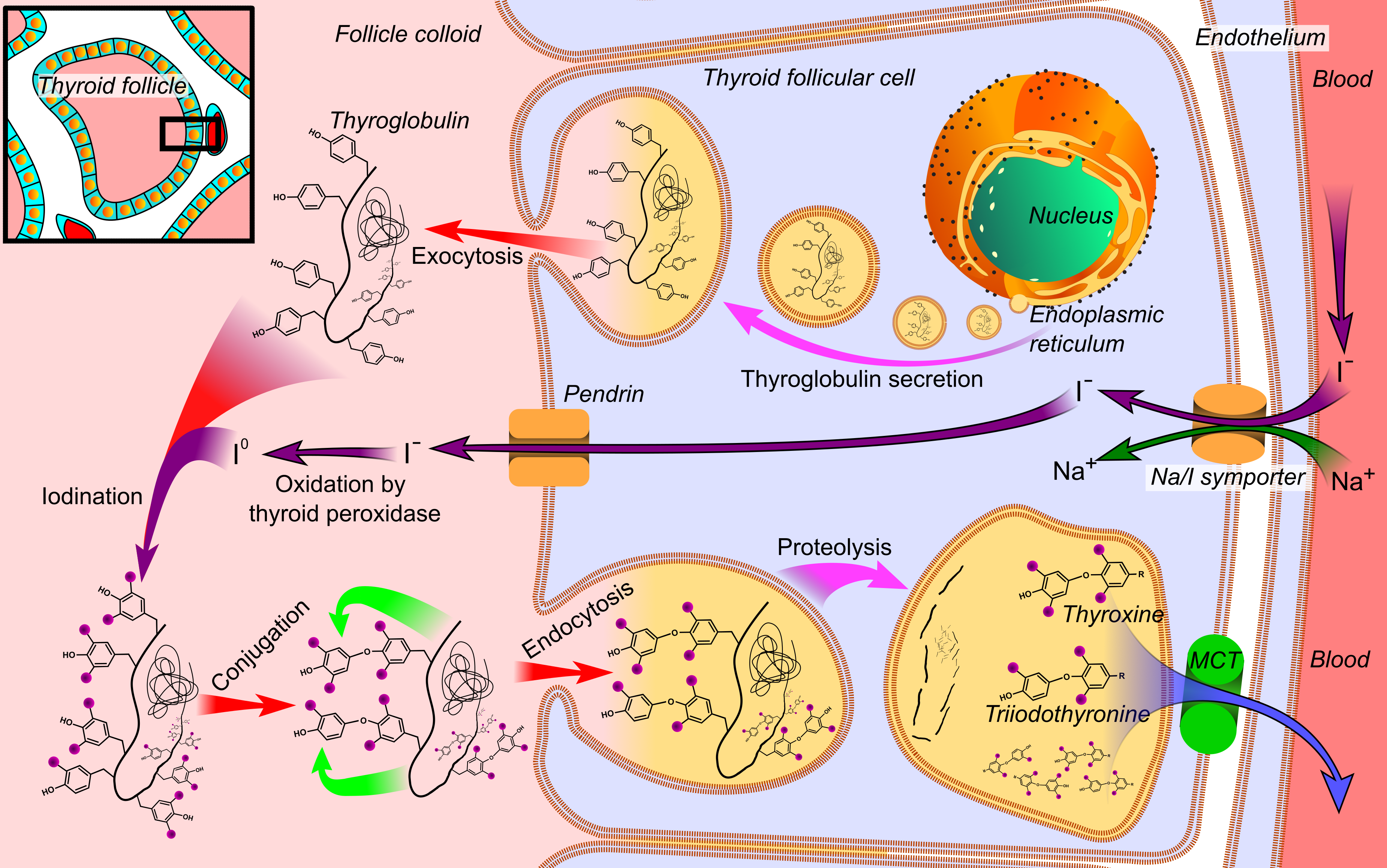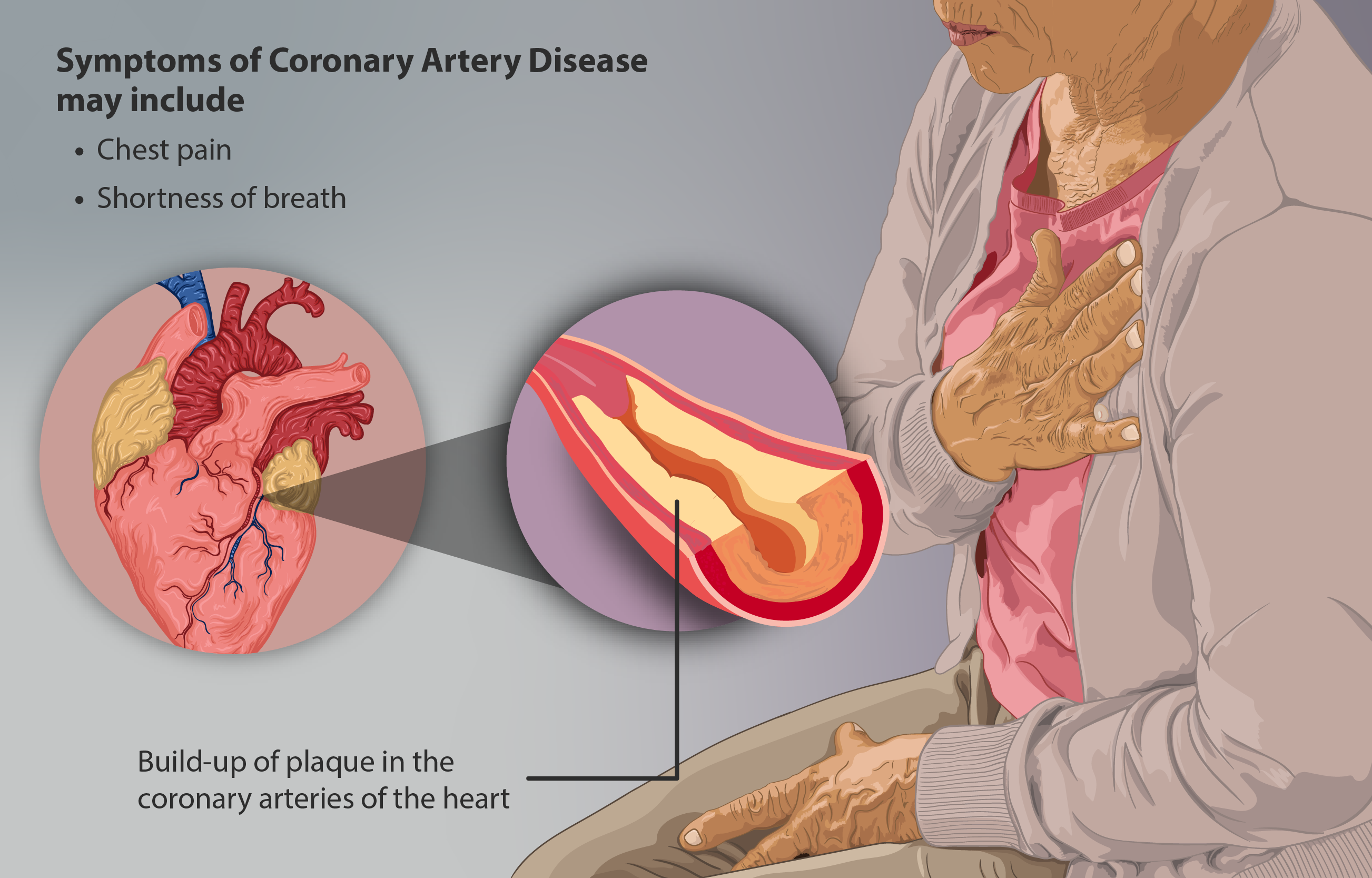|
Levothyroxine
Levothyroxine, also known as -thyroxine, is a synthetic form of the thyroid hormone thyroxine (T4). It is used to treat thyroid hormone deficiency (hypothyroidism), including a severe form known as myxedema coma. It may also be used to treat and prevent certain types of thyroid tumors. It is not indicated for weight loss. Levothyroxine is taken orally (by mouth) or given by intravenous injection. Levothyroxine has a half-life of 7.5 days when taken daily, so about six weeks is required for it to reach a steady level in the blood. Side effects from excessive doses include weight loss, trouble tolerating heat, sweating, anxiety, trouble sleeping, tremor, and fast heart rate. Use is not recommended in people who have had a recent heart attack. Use during pregnancy has been found to be safe. Dosing should be based on regular measurements of thyroid-stimulating hormone (TSH) and T4 levels in the blood. Much of the effect of levothyroxine is following its conversion to tri ... [...More Info...] [...Related Items...] OR: [Wikipedia] [Google] [Baidu] |
Hypothyroidism
Hypothyroidism is an endocrine disease in which the thyroid gland does not produce enough thyroid hormones. It can cause a number of symptoms, such as cold intolerance, poor ability to tolerate cold, fatigue, extreme fatigue, muscle aches, constipation, slow heart rate, Depression (mood), depression, and weight gain. Occasionally there may be swelling of the front part of the neck due to goiter. Untreated cases of hypothyroidism during pregnancy can lead to delays in child development, growth and intellectual development in the baby or congenital iodine deficiency syndrome. Worldwide, iodine deficiency, too little iodine in the diet is the most common cause of hypothyroidism. Hashimoto's thyroiditis, an autoimmune disease where the body's immune system reacts to the thyroid gland, is the most common cause of hypothyroidism in countries with sufficient dietary iodine. Less common causes include previous treatment with iodine-131, radioactive iodine, injury to the hypothalamus ... [...More Info...] [...Related Items...] OR: [Wikipedia] [Google] [Baidu] |
Subclinical Hypothyroidism
Hypothyroidism is an endocrine disease in which the thyroid gland does not produce enough thyroid hormones. It can cause a number of symptoms, such as poor ability to tolerate cold, extreme fatigue, muscle aches, constipation, slow heart rate, depression, and weight gain. Occasionally there may be swelling of the front part of the neck due to goiter. Untreated cases of hypothyroidism during pregnancy can lead to delays in growth and intellectual development in the baby or congenital iodine deficiency syndrome. Worldwide, too little iodine in the diet is the most common cause of hypothyroidism. Hashimoto's thyroiditis, an autoimmune disease where the body's immune system reacts to the thyroid gland, is the most common cause of hypothyroidism in countries with sufficient dietary iodine. Less common causes include previous treatment with radioactive iodine, injury to the hypothalamus or the anterior pituitary gland, certain medications, a lack of a functioning thyroid at ... [...More Info...] [...Related Items...] OR: [Wikipedia] [Google] [Baidu] |
Thyroid Hormone
File:Thyroid_system.svg, upright=1.5, The thyroid system of the thyroid hormones triiodothyronine, T3 and T4 rect 376 268 820 433 Thyroid-stimulating hormone rect 411 200 849 266 Thyrotropin-releasing hormone rect 297 168 502 200 Hypothalamus rect 66 216 386 256 Anterior pituitary, Anterior pituitary gland rect 66 332 342 374 Negative feedback rect 308 436 510 475 Thyroid, Thyroid gland rect 256 539 563 635 Thyroid hormones rect 357 827 569 856 Catecholamine rect 399 716 591 750 Metabolism desc bottom-left Thyroid hormones are two hormones produced and released by the thyroid gland, triiodothyronine (T3) and thyroxine (T4). They are tyrosine-based hormones that are primarily responsible for regulation of metabolism. T3 and T4 are partially composed of iodine, derived from food. A deficiency of iodine leads to decreased production of T3 and T4, enlarges the thyroid, thyroid tissue and will cause the disease known as simple goitre. The major form of thyroid hormone in the blood ... [...More Info...] [...Related Items...] OR: [Wikipedia] [Google] [Baidu] |
Sum Activity Of Peripheral Deiodinases
The sum activity of peripheral deiodinases (''GD'', also referred to as deiodination capacity, total deiodinase activity or, if calculated from levels of thyroid hormones, as SPINA-GD) is the maximum amount of triiodothyronine produced per time-unit under conditions of substrate saturation. It is assumed to reflect the activity of deiodinases outside the central nervous system and other isolated compartments. GD is therefore expected to reflect predominantly the activity of type I deiodinase. ''GD'' is both a theoretical concept that is used in physiological theories of thyroid function and (as a calculated parameter) a biomarker for advanced diagnosis of thyroid disorders. How to determine GD ''GD'' can be determined experimentally by exposing a cell culture system to saturating concentrations of T4 and measuring the T3 production. Whole body deiodination activity can be assessed by measuring production of radioactive iodine after loading the organism with marked thyroxine. ... [...More Info...] [...Related Items...] OR: [Wikipedia] [Google] [Baidu] |
By Mouth
Oral administration is a route of administration whereby a substance is taken through the Human mouth, mouth, swallowed, and then processed via the digestive system. This is a common route of administration for many medications. Oral administration can be easier and less painful than other routes of administration, such as Injection (medicine), injection. However, the onset of action is relatively low, and the effectiveness is reduced if it is not absorbed properly in the digestive system, or if it is broken down by digestive enzymes before it can reach the bloodstream. Some medications may cause gastrointestinal side effects, such as nausea or vomiting, when taken orally. Oral administration can also only be applied to conscious patients, and patients able to swallow. Terminology ''Per os'' (; ''P.O.'') is an adverbial phrase meaning literally from Latin "through the mouth" or "by mouth". The expression is used in medicine to describe a treatment that is taken orally (but not ... [...More Info...] [...Related Items...] OR: [Wikipedia] [Google] [Baidu] |
Goiter
A goitre (British English), or goiter (American English), is a swelling in the neck resulting from an enlarged thyroid gland. A goitre can be associated with a thyroid that is not functioning properly. Worldwide, over 90% of goitre cases are caused by iodine deficiency. The term is from the Latin ''gutturia'', meaning throat. Most goitres are not cancerous (benign), though they may be potentially harmful. Signs and symptoms A goitre can present as a palpable or visible enlargement of the thyroid gland at the base of the neck. A goitre, if associated with hypothyroidism or hyperthyroidism, may be present with symptoms of the underlying disorder. For hyperthyroidism, the most common symptoms are associated with adrenergic stimulation: tachycardia (increased heart rate), palpitations, nervousness, tremor, increased blood pressure and heat intolerance. Clinical manifestations are often related to hypermetabolism (increased metabolism), excessive thyroid hormone, an increase in oxy ... [...More Info...] [...Related Items...] OR: [Wikipedia] [Google] [Baidu] |
Coronary Artery Disease
Coronary artery disease (CAD), also called coronary heart disease (CHD), or ischemic heart disease (IHD), is a type of cardiovascular disease, heart disease involving Ischemia, the reduction of blood flow to the cardiac muscle due to a build-up of atheromatous plaque in the Coronary arteries, arteries of the heart. It is the most common of the cardiovascular diseases. CAD can cause stable angina, unstable angina, myocardial ischemia, and myocardial infarction. A common symptom is angina, which is chest pain or discomfort that may travel into the shoulder, arm, back, neck, or jaw. Occasionally it may feel like heartburn. In stable angina, symptoms occur with exercise or emotional Psychological stress, stress, last less than a few minutes, and improve with rest. Shortness of breath may also occur and sometimes no symptoms are present. In many cases, the first sign is a Myocardial infarction, heart attack. Other complications include heart failure or an Heart arrhythmia, abnormal h ... [...More Info...] [...Related Items...] OR: [Wikipedia] [Google] [Baidu] |
Compliance (medicine)
In medicine, patient compliance (also adherence, capacitance) describes the degree to which a person correctly follows medical advice. Most commonly, it refers to medication or drug compliance, but it can also apply to other situations such as medical device use, self care, self-directed exercises, therapy sessions, or medical follow-up visits. Both patient and health-care provider affect compliance, and a positive physician-patient relationship is the most important factor in improving compliance. Access to care plays a role in patient adherence, whereby greater wait times to access care contributing to greater absenteeism. The cost of prescription medication and potential side effects also play a role. Compliance can be confused with concordance, which is the process by which a patient and clinician make decisions together about treatment. Worldwide, non-compliance is a major obstacle to the effective delivery of health care. 2003 estimates from the World Health Organization ... [...More Info...] [...Related Items...] OR: [Wikipedia] [Google] [Baidu] |
Total Cholesterol
Cholesterol is the principal sterol of all higher animals, distributed in body Tissue (biology), tissues, especially the brain and spinal cord, and in Animal fat, animal fats and oils. Cholesterol is biosynthesis, biosynthesized by all animal Cell (biology)#Eukaryotic cells, cells and is an essential structural and cholesterol signaling, signaling component of animal cell membranes. In vertebrates, hepatocyte, hepatic cells typically produce the greatest amounts. In the brain, astrocytes produce cholesterol and transport it to neurons. It is absent among prokaryotes (bacteria and archaea), although there are some exceptions, such as ''Mycoplasma'', which require cholesterol for growth. Cholesterol also serves as a Precursor (chemistry), precursor for the biosynthesis of steroid hormones, bile acid and vitamin D. Elevated levels of cholesterol in the blood, especially when bound to low-density lipoprotein (LDL, often referred to as "bad cholesterol"), may increase the risk of ... [...More Info...] [...Related Items...] OR: [Wikipedia] [Google] [Baidu] |
LDL Cholesterol
Low-density lipoprotein (LDL) is one of the five major groups of lipoprotein that transport all fat molecules around the body in extracellular water. These groups, from least dense to most dense, are chylomicrons (aka ULDL by the overall density naming convention), very low-density lipoprotein (VLDL), intermediate-density lipoprotein (IDL), low-density lipoprotein (LDL) and high-density lipoprotein (HDL). LDL delivers fat molecules to cells. LDL has been associated with the progression of atherosclerosis. Overview Lipoproteins transfer lipids (fats) around the body in the extracellular fluid, making fats available to body cells for receptor-mediated endocytosis. Lipoproteins are complex particles composed of multiple proteins, typically 80–100 proteins per particle (organized by a single apolipoprotein B for LDL and the larger particles). A single LDL particle is about 22–27.5 nanometers in diameter, typically transporting 3,000 to 6,000 fat molecules per particle and v ... [...More Info...] [...Related Items...] OR: [Wikipedia] [Google] [Baidu] |
Etiology
Etiology (; alternatively spelled aetiology or ætiology) is the study of causation or origination. The word is derived from the Greek word ''()'', meaning "giving a reason for" (). More completely, etiology is the study of the causes, origins, or reasons behind the way that things are, or the way they function, or it can refer to the causes themselves. The word is commonly used in medicine (pertaining to causes of disease or illness) and in philosophy, but also in physics, biology, psychology, political science, geography, cosmology, spatial analysis and theology in reference to the causes or origins of various phenomena. In the past, when many physical phenomena were not well understood or when histories were not recorded, myths often arose to provide etiologies. Thus, an etiological myth, or origin myth, is a myth that has arisen, been told over time or written to explain the origins of various social or natural phenomena. For example, Virgil's ''Aeneid'' is a national myth ... [...More Info...] [...Related Items...] OR: [Wikipedia] [Google] [Baidu] |
Body Mass Index
Body mass index (BMI) is a value derived from the mass (Mass versus weight, weight) and height of a person. The BMI is defined as the human body weight, body mass divided by the square (algebra), square of the human height, body height, and is expressed in Units of measurement, units of kg/m2, resulting from mass in kilograms (kg) and height in metres (m). The BMI may be determined first by measuring its components by means of a weighing scale and a stadiometer. The multiplication and division may be carried out directly, by hand or using a calculator, or indirectly using a lookup table (or chart). The table displays BMI as a function of mass and height and may show other units of measurement (converted to Metric system, metric units for the calculation). The table may also show contour lines or colours for different BMI categories. The BMI is a convenient rule of thumb used to broadly categorize a person as based on tissue mass (muscle, fat, and bone) and height. Major adult B ... [...More Info...] [...Related Items...] OR: [Wikipedia] [Google] [Baidu] |







